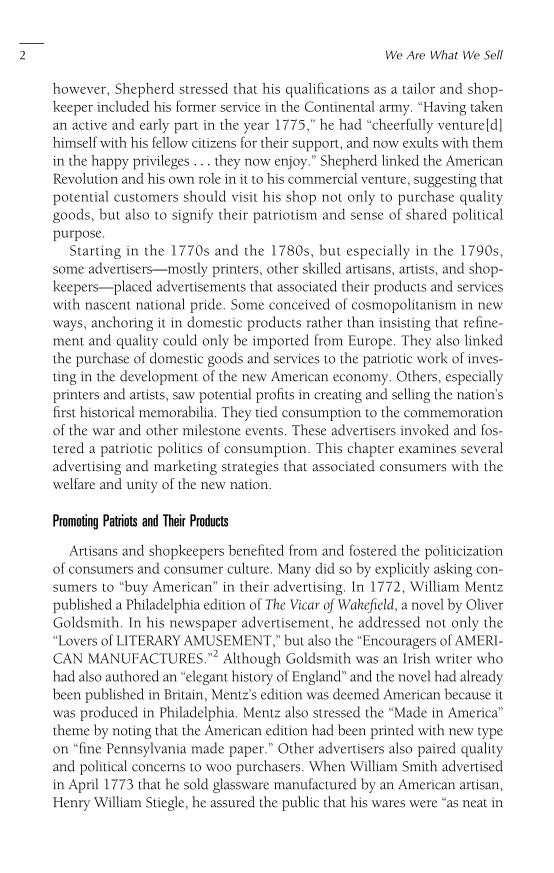2 We Are What We Sell however, Shepherd stressed that his qualifications as a tailor and shop- keeper included his former service in the Continental army. “Having taken an active and early part in the year 1775,” he had “cheerfully venture[d] himself with his fellow citizens for their support, and now exults with them in the happy privileges ... they now enjoy.” Shepherd linked the American Revolution and his own role in it to his commercial venture, suggesting that potential customers should visit his shop not only to purchase quality goods, but also to signify their patriotism and sense of shared political purpose. Starting in the 1770s and the 1780s, but especially in the 1790s, some advertisers—mostly printers, other skilled artisans, artists, and shop- keepers—placed advertisements that associated their products and services with nascent national pride. Some conceived of cosmopolitanism in new ways, anchoring it in domestic products rather than insisting that refine- ment and quality could only be imported from Europe. They also linked the purchase of domestic goods and services to the patriotic work of inves- ting in the development of the new American economy. Others, especially printers and artists, saw potential profits in creating and selling the nation’s first historical memorabilia. They tied consumption to the commemoration of the war and other milestone events. These advertisers invoked and fos- tered a patriotic politics of consumption. This chapter examines several advertising and marketing strategies that associated consumers with the welfare and unity of the new nation. Promoting Patriots and Their Products Artisans and shopkeepers benefited from and fostered the politicization of consumers and consumer culture. Many did so by explicitly asking con- sumers to “buy American” in their advertising. In 1772, William Mentz published a Philadelphia edition of The Vicar of Wakefield, a novel by Oliver Goldsmith. In his newspaper advertisement, he addressed not only the “Lovers of LITERARY AMUSEMENT,” but also the “Encouragers of AMERI- CAN MANUFACTURES.”2 Although Goldsmith was an Irish writer who had also authored an “elegant history of England” and the novel had already been published in Britain, Mentz’s edition was deemed American because it was produced in Philadelphia. Mentz also stressed the “Made in America” theme by noting that the American edition had been printed with new type on “fine Pennsylvania made paper.” Other advertisers also paired quality and political concerns to woo purchasers. When William Smith advertised in April 1773 that he sold glassware manufactured by an American artisan, Henry William Stiegle, he assured the public that his wares were “as neat in
Document Details My Account Print multiple pages
Print
You have printed 0 times in the last 24 hours.
Your print count will reset on at .
You may print 0 more time(s) before then.
You may print a maximum of 0 pages at a time.



















































































































































































































































































































































































































































































































































































































































































































































































































































































































































































































































































































